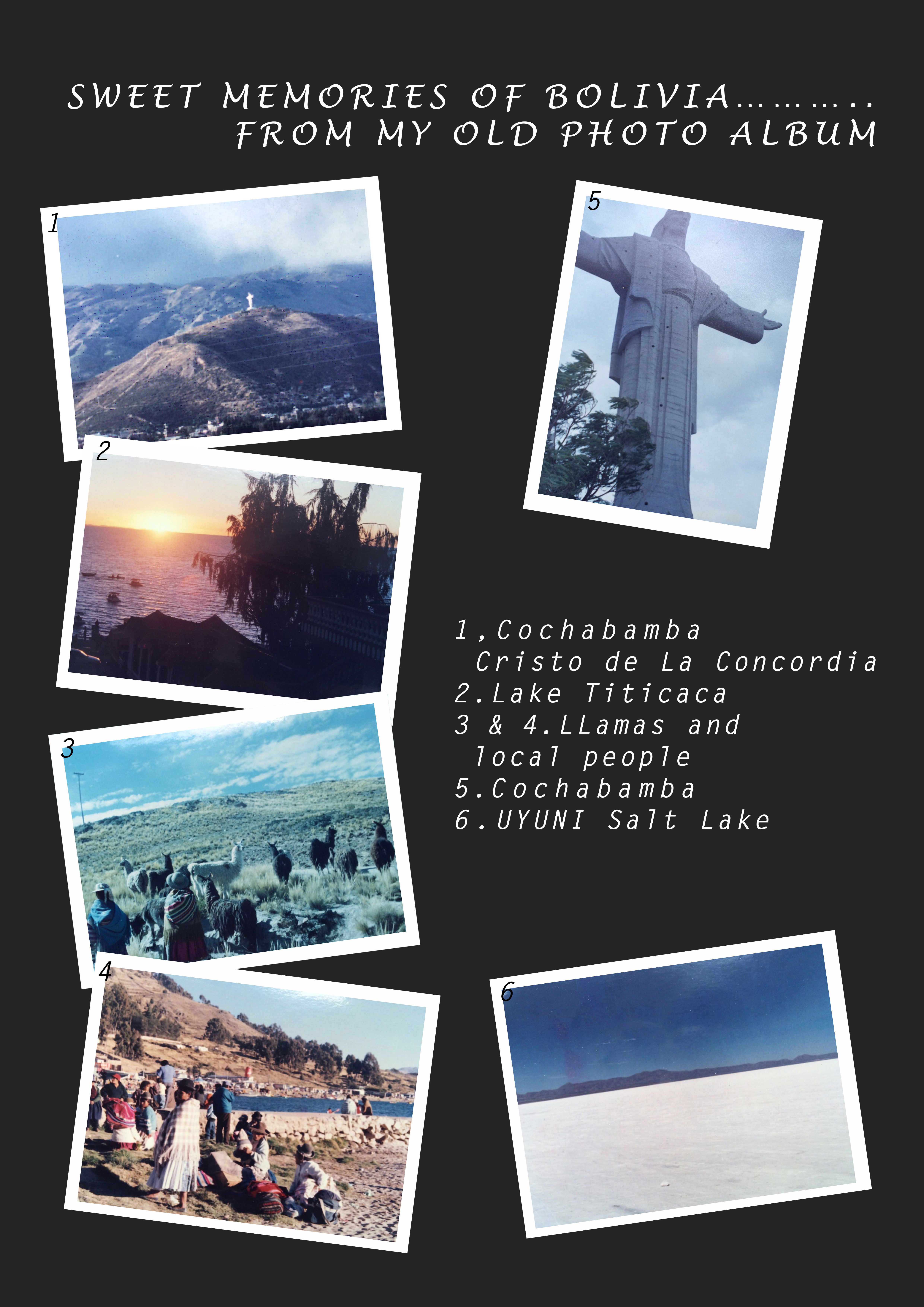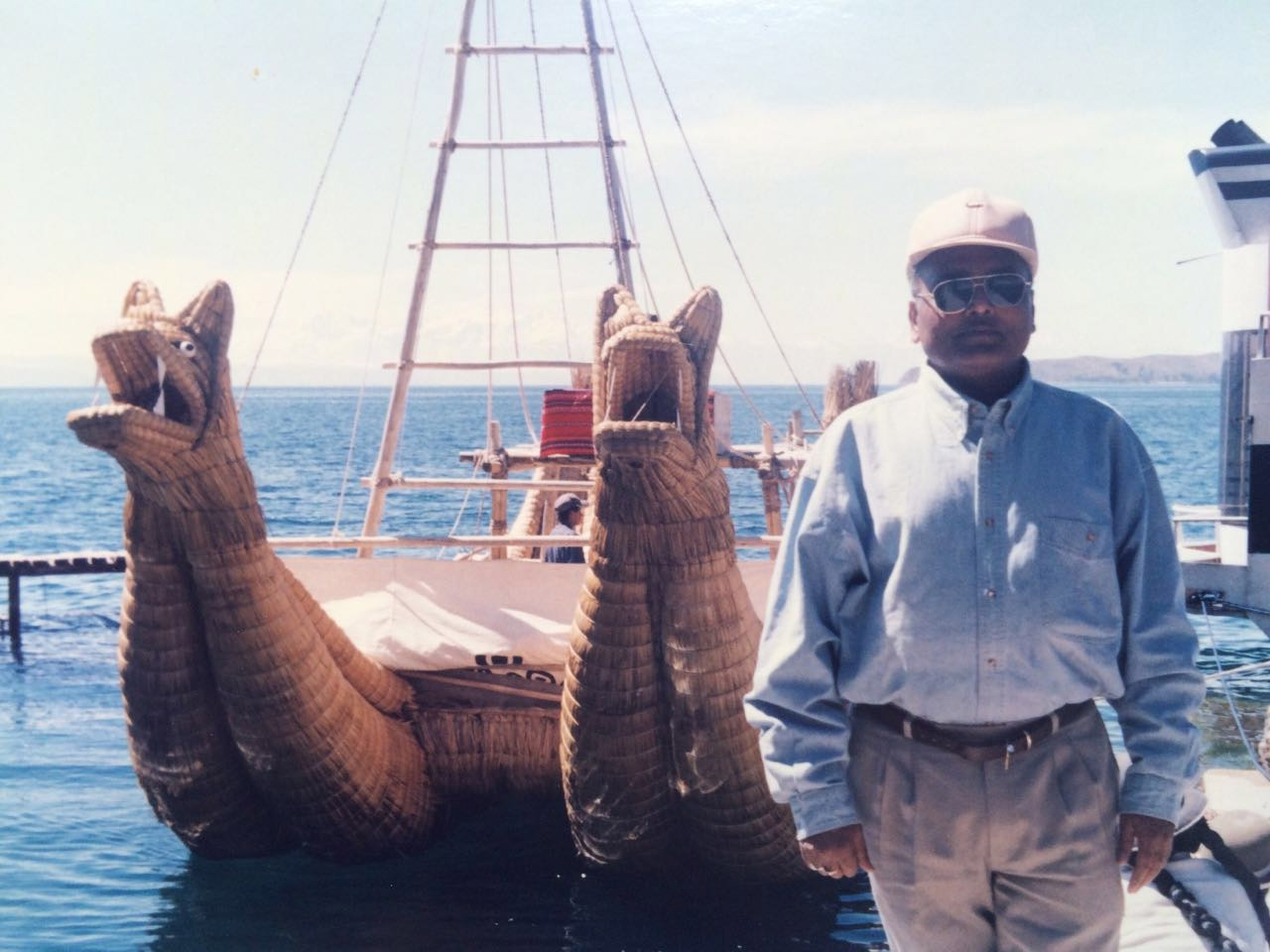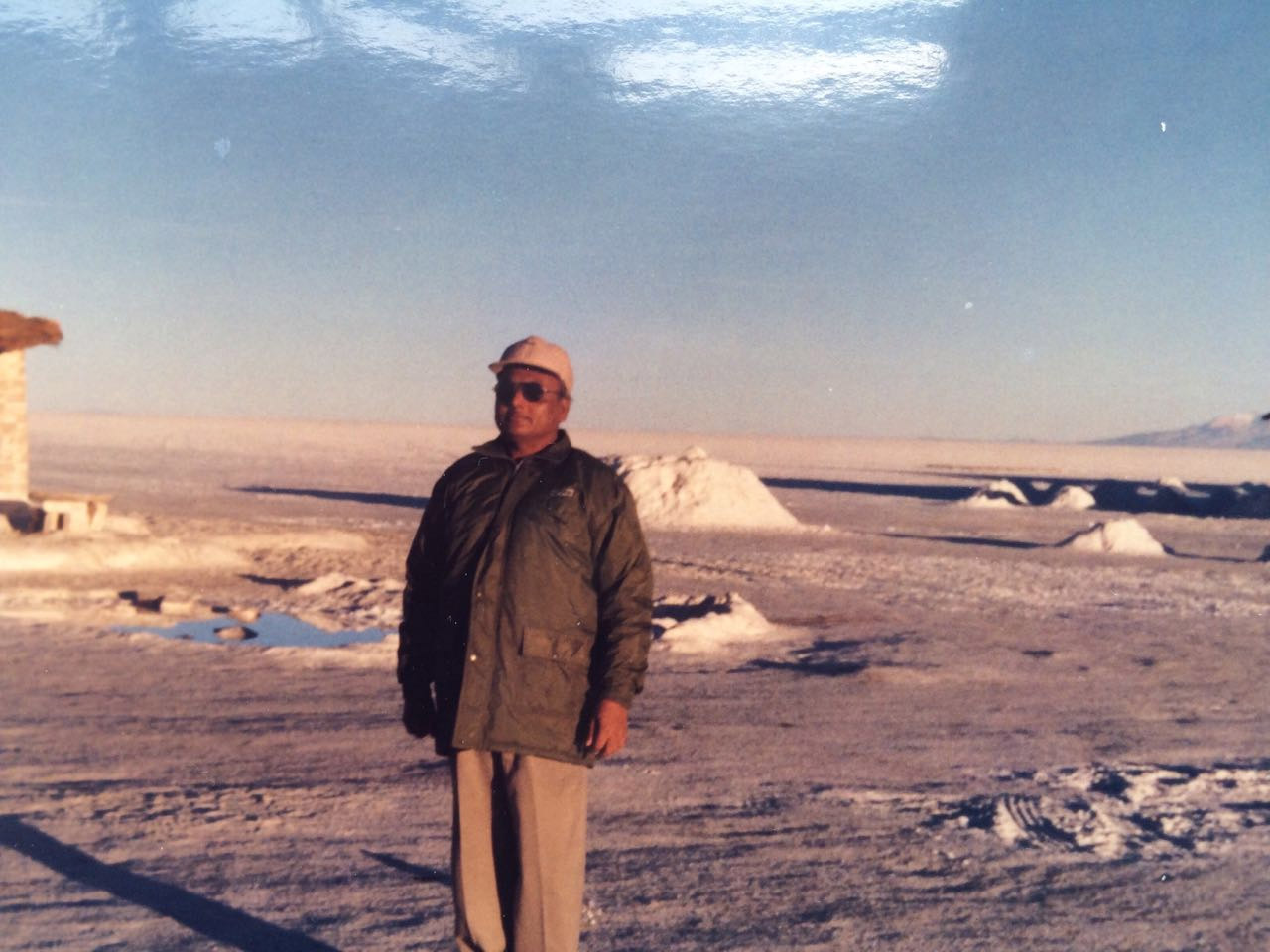Subrata De
What matters in life is not what happens to you but what you remember and how you remember it.
Gabriel Garcia Marquez

Bolivia was an unknown place for me. Little did I know that this beautiful country of South America blessed with deep forests, springs, high altitude lakes and hills, is at the same time a storehouse of rich mineral deposit of nonferrous metal like tin, gold and copper. I had visited a few other countries of the world by then, but never in my dreams thought of visiting Bolivia – that too not as a tourist but as an engineer serving in that country for some time.
At the very outset, let me confess that I am a poor wordsmith. Whatever I have written is culled from my memory and viewed through the lens of an enthusiastic and inquisitive layman who had the good fortune to visit Bolivia. At this age, memory too plays with me…… however as far as I can recapitulate, it was in the month of March 2001 (Those days, I was posted at Baia Mare Copper Plant in Romania) when I was suddenly called for an emergency meeting at our London head office. Our CMD requested me to take charge of our Bolivian tin mines and plant situated at Oruro, approximately 150 kms from La Paz, the capital of Bolivia.
Happy with the prospect of visiting a part of South America I immediately agreed for the new assignment. Bolivian Visa was issued from the Bolivian Embassy at London in those days (back then there was no Bolivian embassy in India, and it had to be issued from London only). I came to Kolkata before leaving for my new assignment.
Those days British Airways had a flight from Kolkata to Bolivia. It was a very long flight having multiple stop overs and connecting flights via London, Sao Paulo, Santa Cruz , and ultimately to La Paz, the capital city at the highest altitude of the world.The total flying time was almost 36 hours to reach my destination (including the layover time). I had to learn a bit of Spanish, the official language for basic communication.
After I landed at La Paz, I was served Coca tea prepared from the Coca leaves. I was also given a few coca leaves to chew (as in we take betel leaf or paan) to prevent altitude sickness and acclimatize in that high altitude environment. Fortunately, unlike most visitors, I was not feeling drowsy or sick. coca leaves had for sure done their magic.
We had our lunch at a restaurant at La Paz. Bolivians are mostly rice eaters and almost all Indian vegetables, like potato, cabbage, cauliflower, radish and other tropical vegetables are grown and cultivated at lower altitudes. The Amazon basin is famed for producing good variety of pineapple and papaya. Juicy and sweet mango are imported from Brazil. At the same time, these parts of South America also continue with illegal and unauthorized farming of poppy plants (used to extract opium to produce drugs). Some amazing variety of fresh water fishes are also available. I fondly remember the trout among others. Lamb, chicken and beef are easily available. Cochabamba in Bolivia produces very sweet oranges. Almost every house has an orange tree. Like most Bengalis, I am a foodie. So whichever country I visit, I make it a point to gather some ideas about their local cuisine. This in turn helps me to know their culture, food and improvise my food intake. I also do not miss an opportunity to visit local markets. Bolivia gave me a feel of our very own Indian markets……somewhat like our “haats”.
I had a short visit of the city. It looked like Darjeeling or Sikkim. The roads were so steep that we had to use hand brakes if we stopped midway. Most of the hills were covered with snow dazzling in the sunshine. Shades are a must to cut off the glare. Though it was not winter, it was very cold and I learnt that due to the high altitude, it remained cold throughout the year.
From La Paz, I had to go to my work place at Oruro, almost a 2 hour-long drive. On my journey, I was accompanied by an Indian office colleague who had worked with me at Romania before. It was a beautiful road. We were passing through lots of small towns and villages. Many boys were playing football which is a very popular game here. Llama, sheep and alpaca (resembles a goat) were found plenty in number. It looked like we were crossing from one hill to another. The area was full of unknown flowers and varieties of cactus.
Ultimately, we reached our own campus Oruro at Playa Verde (In Spanish, Playa Verde means green valley). The soft gurgling sound from a scantily flowing river, the mellowed sunset lent an ethereal glow to this place. My bungalow was situated on the bank of this river (Later I came to know its name as Hanuny River). However, during the rainy season, it gets flooded and sometime water reaches our campus). The campus was really a solitary valley and our plant was approximately 2 kms away from my residence. The whole area was surrounded by lots of small barren rocky hills sans vegetation. Only the foot of the hills were covered with long grass and cactus. The local language of Oruro is Spanish and the natives do not know any other language. One of their major profession is farming Llama, sheep, and alpaca (generally, it is the ladies who move with a flock of sheep or Llama for grazing, from one hill to other). As far as cultivation is concerned, they grow soybeans, ground nuts etc. But majority of the community members are miners. Many make a living by selling the tin ore which they collect by manual shaking and sieving of the river water that contains residual ore after ore dressing. (I had experienced the same at Ghatsila where local people use to collect gold dust from Subarnarekha River). I remember, near Oruro there was a hot spring. Since the weather was very chilly, we used to frequent the hot spring which was well maintained. The swimming area was nice with facilities for natural sauna bath.
The local people are sturdy and stocky like the people of Nepal or Bhutan, or any other natives of the hilly regions of India. The next morning I and my colleague (a metallurgist by profession) had a nice breakfast. The only problem was that it took a lot of time for boiling food at high altitude. Our lady cook knew very basic English so I could order some food. Within a few days, however, I was compelled to learn Spanish names of the food items to avoid hunger pangs.
Previously,I was accustomed to underground mines or open cast mines but this tin mine was absolutely a hill. We had to enter the main gate of the mines through an elevator. Tunnels with rail track and Low Voltage Electric car over rail track took me inside the mines. The nugget tin ore had a very high percentage of tin, as high as 30 to 60 % and balance around 8 to 10%. There was a big security problem in this mine. All the miners looked alike and in case a miner’s brother would enter through a different tunnel from the other side of the entrance (Security gate), it became very difficult to distinguish him. These men called Jukus (pronounced hukus, in Spanish means a thief) were really a menace.
From the dreary mines of Bolivia, let me take the readers to the rich and vibrant culture of Bolivia. A Bolivian痴 life is a zesty mix of the hot lokoto (Mexican chilli) and the sweet cocada (coconut candies). Song and dances are a vital part of their culture. The drum beats are intoxicating like the much loved chica de jora (locally brewed maize beer). Given a chance, one must not miss the Carnaval de Oruro (carnival) – a unique cultural extravaganza. Celebrated for over 200 years, it is one of UNESCO masterpieces of the Oral and Intangible Heritage of Humanity. For months young men and women prepare for the dances representing their culture and tradition. Young men and beautifully dressed senoritas shall walk down the streets in pomp and gaiety. These days the younger generation is geared towards education provided by schools and universities. Bolivians are friendly and fun loving. The men (Senior) are always game for a drink, a friendly chat, dance and siesta and like to enjoy more than they work and earn. Bolivian women (Seniora) are very hard working. They multitask and raise their family. However, no matter how hard a day goes by, no Seniora shall refrain from a dance to set alight her spirit. The Bolivians are equally enthusiastic about football. For most, football is a religion. Since I did not know Spanish, I could not enjoy Bolivian literature. Bolivia has great writers. Many amongst them are very politically conscious.
As I write, I recollect a few other places of interest that I could cover during my stay. As I attempt to tread through those alleys, dear readers, hold my hand steady. Forgive me for the mistakes of omission or commission in course of this travelogue…. for I am no writer and I only write what has appealed me most.
COCHABAMBA and Cristo de La Concordia
With fantastic scenic beauty, lots of trees, beautiful parks and flower gardens, the city Cochabamba can boast as one of the major tourist attraction of Bolivia. This city of central Bolivia was in fact a fertile valley and was once home of the indigenous ethnic groups: Tiwanaku, Tupariya and the Incas before the Spanish invasions. Even today at almost every house of Cochabamba one shall be welcomed with orange, avocado and apple trees. Grapes are also produced in their fertile soil.
Today it is one of the most important cities of Bolivia housing the Cristo de la Concordia (Christ of Peace). This statue of Jesus Christ is located atop San Pedro Hill, to the east of Cochabamba. The statue is higher than that of Christ the Redeemer in Brazil .It is accessible by cable car, or by climbing 2,000 steps.
.. LAKE TITICACA AND INCA CIVILIZATION

The author at Lake Titicaca
Copacabana is the main Bolivian town on the shore of Lake Titicaca (the highest navigable lake). In one of our visits to Copacabana, we stayed at a beautiful hotel by the Lake Side. A part of the lake extends to Peru. Dotted with small islands and hills, the lake is accessible by motor boats. Among the many hills, we found one quite crowded and people waiting in long queue. This was a place of worship for the devout. It did not have a shrine or an idol, but a stone where people prayed for fulfilment of desire. If they purchase a new car, they come to this holy place at Copacabana of Titicaca and would go to the hilltop to break a bottle of champagne. We found thousands of broken bottles dumped for collection. I was reminded of varied but similar rites in Hindu culture expressing adoration of the Divine. Lake Titicaca is vast and to a first timer it seems like a sweet water ocean. One cannot see the other side of the lake. We enjoyed a hearty meal of rice and Trucha (Trout fish) which is available plenty in this lake.
A visit to the well maintained museum of the Inca civilization was very memorable. Many sculptures, artefacts and remnants of this great civilization were preserved as relics bearing testimony to their glorious days.
UYUNI SALT LAKE

At Lake Uyuni
The place Uyuni is almost 6 hours drive from Oruro. The journey was tedious. I along with four Indian families and two young bachelors travelled by car and reached Uyuni Salt Lake (popularly known as Salar de Uyuni), the world’s largest salt flat at 10,582 square kilometres.
We were driving on the surface of salt, as if we were driving over hard marble. There was only one hotel which we had booked in advance. The cottage of the hotel was made of salt blocks. Only in the roofs tin sheets were used. But the interior was totally different. It was as good as any other luxury hotel. The beds were made of salt blocks and foam mattress was kept on it. Continental food was available. The hotel was looking like an isolated island in the Salt Lake. It was difficult to believe that we were driving on salt slabs. Our guide dug a hole to show us that the water was found just a meter below. The entire Salt Lake was floating. In fact when we reached the spot it was almost evening and our plan was to visit the place next morning. Fortunately, it was a full moon night and I cannot express in words how beautiful the spectacle was. Moon light was reflecting on the white salt lake. It seemed we were in a different planet. We were enjoying the exceptional beauty braving tremendous cold and chilly wind.
We had a warm and once in a lifetime sleep on the Salt Cot. In the morning, we had a nice breakfast and our guide showed us the place. There was every possibility of getting lost without a guide. It was as if we were in a salt desert. The borders of the Salt Lake were lined by numerous dead volcanos. We had the privilege to see some of them. Cactus jungles, rather Cactus Park grew along the border of the lake. The beauty seemed surreal.
I found the Bolivian people warm and hospitable. Language was a great barrier, however, I enjoyed my almost year-long stay at Bolivia. It was indeed an unforgettable experience!
Photographs: By the author
